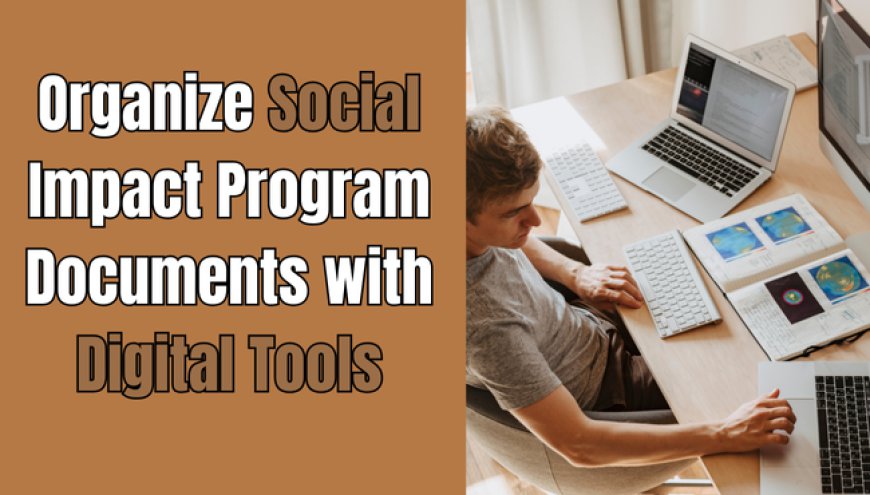Organize Social Impact Program Documents with Digital Tools
In the social impact program, properly managed documents are prerequisites to proper organization, compliance, and transparency between the parties involved.

Key Takeaways
-
Digital tools improve efficiency and collaboration.
-
Digital tools prevent errors in large data volumes.
-
Document accuracy ensures trust and compliance.
-
PDF tool integration streamlines workflows.
-
Training optimizes digital tool usage.
In the social impact program, properly managed documents are prerequisites to proper organization, compliance, and transparency between the parties involved. With all reports and proposals, data, and no manual handling, traditional document management is inefficient and prone to errors. Among all, digital tools, mainly PDF management, streamline the process of addressing such documents. It improves productivity and enhances collaboration, keeping all the necessary documents accessible, secure, and up-to-date through easy editing, file merging, and conversion.
Key Challenges in Organizing Social Impact Program Documents

Managing Huge Amounts of Data: Social impact programs normally generate massive documents in the form of reports, financial statements, project proposals, and communication with stakeholders. The larger the program is and the broader the scope, the harder it will be to control the entry of data. Retrieving organized documents on particular issues will take so much time and is prone to error due to manual or archaic systems.
Ensuring Document Accuracy and Consistency: Social impact programs need documents to be free from discrepancies-whether these are in the reports of the program, funding proposals, or data entries. Accidental errors during editing and updating could create confusion or miscommunication, not to mention serious compliance issues. Therefore, robust systems and practices are necessary to ensure that all team members have updated versions of documents and do not make errors during editing and updates. Otherwise, the risk of inaccuracy would increase and subsequently affect the outcome of programs and trust with stakeholders.
Collaboration Among Teams and Stakeholders: Teams and stakeholders involved in social impact programs often work across a wide range of teams and stakeholders - for example, funding agencies, community partners, and government. The coordination of document sharing, providing feedback, and revisions can be complicated without the proper tools. Without an effective version control system for document communications and proper conveyance of information about changes, teams would find it tough to track changes, and get information on time, and from others in due course. Effective partnerships are the foundation of such programs, so streamlined processes that can easily and transparently handle documents are the priority.
Benefits of using digital tools for document management

Saving time, efficiency, and efficient handling of documents: Also, time spent on manual administrative work has dramatically reduced due to digital tools. Since automatic indexing, search functions, and batch processing take place, information is retrieved and processed much faster. Social impact programs can automate routine tasks, thereby making workflows more streamlined and significantly raising the effectiveness of operational functioning.
Improved Accessibility and Sharing Capabilities: When using digital tools, documents can easily be accessed and shared in real-time regardless of location. This is particularly crucial for social impact programs with dispersed teams or global stakeholders as it ensures that team members work together seamlessly and make decisions on time following the latest information.
Increased Security and Backup Mechanism: The digital tool offers robust security features that are much more reliable than storage in physical forms. These tools protect sensitive program data against unauthorized access and loss by using encryption, secure cloud storage, and access control mechanisms. Cloud-based systems provide automatic backup; hence, program documents will be safe should hardware fail or other disasters occur.
PDF Tools to Organize Documents in Social Impact Programs

Editing PDFs: After editing PDFs, it is easy to update existing content quickly in reports, proposals, and forms; therefore, they do not go out of date. At whichever point you would like to correct any spelling or grammar mistakes, add new data, or even just revise existing text, PDF editing tools provide an easy means to simply do this without having to recreate the entire document. It is very helpful in social impact projects where reports and documents constantly need to be updated so that teams can be uniform and ensure that only the latest info is used.
Merge PDF: Merging PDFs is another very practical tool for putting together many different documents into one cohesive file. This is particularly useful in social impact programs whereby people are submitting individual reports, forms, or datasets that will need to be compiled into one comprehensive document. One can easily merge materials such as funding proposals, reports of progress, meeting notes, etc. then share and review all the information at a glance.
Breaking up PDFs: PDF splitting enables the selection and extraction of a document's parts for sharing or review purposes. In social impact programs, this would be useful when parts of a particular document need to be shared or reviewed with another team or stakeholder, such as financial reports or project updates. It's also a streamlined communication tool wherein unnecessary information is not sent because the files are smaller and more targeted.
Converting PDF to Word: Converting PDFs to Word documents allows you to achieve an editable version that facilitates collaboration and rewriting more easily. This is particularly convenient when teams seek to alter a final report, form, or application for a grant. Conversion of PDFs to Word makes text manipulation easier and simplifies the incorporation of feedback, editing, and keeping the document flexible for future use. This process of conversion helps ensure seamless collaboration in social impact programs, where documents are required to pass through versions and versions, with updates and revisions, before final submission.
Introduction to Digital Tools in Your Social Impact Program
Best Practice: Choosing Tools Based on Project Needs: Selecting digital tools for document management starts with understanding the project’s specific needs. Consider the volume of documents, required collaboration, and document types such as reports or proposals. Tools should support real-time editing and secure sharing, especially when working across teams. Ensuring compatibility with existing systems will help streamline workflows and enhance productivity.
Workflow Integration: How to Integrate PDF Tools with Other Programme Management Platforms: Integrating PDF tools into the program workflow is key to efficiency. Identify stages where document management is crucial, like report creation or final submissions. Features such as editing, merging, and converting PDFs can be linked to project management or cloud platforms for smoother execution. This integration minimizes delays and ensures the program runs efficiently.
Training and Support for Team Members to Optimize Tool Use: To maximize tool effectiveness, invest in training and ongoing support for team members. Provide step-by-step tutorials on key PDF features, such as merging, editing, and converting documents. Regular workshops will keep everyone updated on new tools, and a robust support system will help resolve issues quickly, preventing work delays.
In a Nutshell
Digital tools are essential for effectively managing documents in social impact programs, offering significant benefits in terms of efficiency, security, and collaboration. By selecting the right tools based on project needs and integrating them into existing workflows, programs can streamline document handling and ensure smooth communication among teams and stakeholders. Proper training and support for team members further enhance the utility of these tools, ensuring that the program operates with accuracy and consistency. Ultimately, embracing digital document management not only saves time and reduces errors but also strengthens the overall impact of social initiatives.

 karioharry12
karioharry12